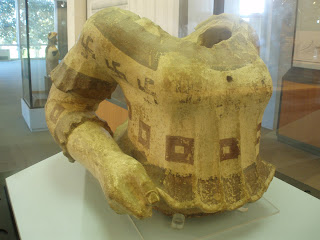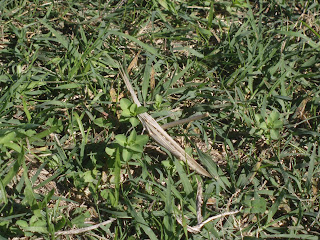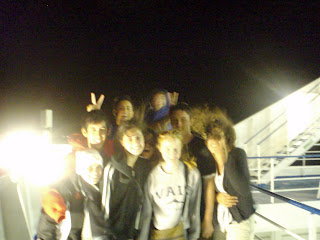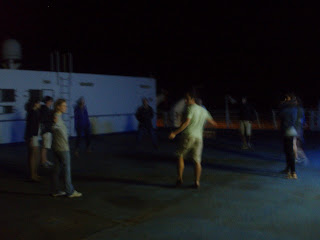While we were all super excited to go see the temples, our first stop was actually at the museum. There was a very nice red-figure vase that had a room all to itself, because the vase had been returned to Paestum (where it had been made in ancient times) from a different museum.
The vase! It depicts the abduction of Europa by Zeus (as a white bull).
All around the outside of the vase room were these panels, which are called metopes (the parts with the sculpted reliefs) and triglyphs (the three skinny columns in between the metopes). These were found in a pile near a treasury at Heraion (which we later saw the very sparse remains of) and have been put together in as close to the original order as could be determined. The panels go in cycles, telling different stories, primarily about Hercules.
This is a metope depicting a man riding a turtle. There is no known myth for this—it’s yet another one of those “we don’t have a clue” mysteries. Yay, mysteries!
We also saw the panels from a painted tomb, which is a rare example of polychromatic Greek painting, and unusual because the Greeks didn’t paint their tombs, so this is an example of the Etruscan and Greek influence in the area. It’s called the Tomb of the Diver. See if you can spot why ;)
I photographed them in the order they were in at the museum--the short panels on the ends would be the ends of the tomb, the longer panels are the sides, and the diver panel would have been the top, facing inward.
I photographed them in the order they were in at the museum--the short panels on the ends would be the ends of the tomb, the longer panels are the sides, and the diver panel would have been the top, facing inward.
The tomb and the metopes were definitely the best parts of the museum, but there was also some other cool stuff in the museum. Lots of pottery! Sadly, they don’t photograph well.
Here's a sandal-ed foot in terra cotta--I'm amazed it survived in one piece.
This is a very finely detailed amphora.
I'm not sure if this was a bust that just happened to be more detailed than normal, or part of a larger statue. I liked the level of detail, and the painted designs.
Oh look! A column capital! You’ve seen lots of Corinthian capitals, because they’re my favorite, so I figured I’d give you a break—this is an Ionic capital, the predecessor to the Corinthian order.
A case of beads and bronze jewelry--I had to take a picture for Mom :)
Here's a sandal-ed foot in terra cotta--I'm amazed it survived in one piece.
This is a very finely detailed amphora.
I'm not sure if this was a bust that just happened to be more detailed than normal, or part of a larger statue. I liked the level of detail, and the painted designs.
Oh look! A column capital! You’ve seen lots of Corinthian capitals, because they’re my favorite, so I figured I’d give you a break—this is an Ionic capital, the predecessor to the Corinthian order.
A case of beads and bronze jewelry--I had to take a picture for Mom :)
After the museum, we finally got to head over to the temples and the rest of the ruins. The ruins included a Roman forum and comitium (public assembly), as well as a Greek agora and bouleterion (public assembly). The doubling up is unusual, usually the Romans simply adapted previous buildings to their use when they take over an area, but this was during a time when the Romans weren’t very happy with the Greeks, so they did their best to wipe out the Greek influence in the area. The forum/agora are somewhat difficult to take pictures of, as they're essentially wide open spaces. There was also an amphitheater, which I was also unable to get a good shot of--mainly because there's a modern road neatly bisecting it.
Here's really the best shot I have of the forum--it's to the right. It's a nice overview of how the site looked though!
Here's really the best shot I have of the forum--it's to the right. It's a nice overview of how the site looked though!
Here's the Greek bouleterion--unfortunately my knowledge of Greek architecture is extremely limited. As I said before, it was a public assembly place.
Here's the Roman equivalent of the bouleterion--the comitium. Somehow I neglected to get a proper picture of the structure as a whole, so you get the Centristi flooding out of it after our lecture--it looks much the same as the bouleuterion, except that it's square instead of round, and built up from the ground instead of built down into a hillside.
This one is somewhat unusual—it’s a piscina, which is basically a swimming pool (Dora is standing on the outer edge of it, giving her lecture). It’s huge, as you can see—it’s 47 by 21 meters, and probably was a lot deeper than it currently is. It was lined with limestone slabs and covered with waterproof concrete. The more I learn about Roman architecture, the more I love it.
This is the remains of a later Roman temple, which was sadly not our focus on this trip, so we briefly went over it and moved on to the next Doric temple.
We also saw this defensive wall, in our time before lunch. We got to climb up onto it and walk along it for a while, which was terrifying but amazing. There were some great views!
Here's the Roman equivalent of the bouleterion--the comitium. Somehow I neglected to get a proper picture of the structure as a whole, so you get the Centristi flooding out of it after our lecture--it looks much the same as the bouleuterion, except that it's square instead of round, and built up from the ground instead of built down into a hillside.
This one is somewhat unusual—it’s a piscina, which is basically a swimming pool (Dora is standing on the outer edge of it, giving her lecture). It’s huge, as you can see—it’s 47 by 21 meters, and probably was a lot deeper than it currently is. It was lined with limestone slabs and covered with waterproof concrete. The more I learn about Roman architecture, the more I love it.
This is the remains of a later Roman temple, which was sadly not our focus on this trip, so we briefly went over it and moved on to the next Doric temple.
We also saw this defensive wall, in our time before lunch. We got to climb up onto it and walk along it for a while, which was terrifying but amazing. There were some great views!
Finally (jumping back a bit--we visited these along the way, but there's the most pictures of them so I separated them), the temples—these are all Doric temples, which was the first and simplest order. Doric order columns have no base and are capped with a simple echinus capital. The different orders aren’t just the columns, but they’re the easiest way to identify which order a particular building is. In case you're curious, another clear indication of a Doric temple is the presence of the triglyphs and metopes.
It's almost like I take pictures just to be able to illustrate these things! The echinus capitals are the pillowy looking bits at the top of the column (interestingly, the more pillowy an echinus is, the earlier it was built--later echinus capitals have a more angular look). Above the columns is the (apparently blank) frieze, which would have been painted in ancient times. Above the frieze are the triglyphs and metopes. Below the triglyphs are little tooth-like decorations, consisting of the regulae (the rectangular parts) and the guttae (the teeth themselves). And if you think that's all excessive amounts of detail, imagine having to learn it for a test :)
It's almost like I take pictures just to be able to illustrate these things! The echinus capitals are the pillowy looking bits at the top of the column (interestingly, the more pillowy an echinus is, the earlier it was built--later echinus capitals have a more angular look). Above the columns is the (apparently blank) frieze, which would have been painted in ancient times. Above the frieze are the triglyphs and metopes. Below the triglyphs are little tooth-like decorations, consisting of the regulae (the rectangular parts) and the guttae (the teeth themselves). And if you think that's all excessive amounts of detail, imagine having to learn it for a test :)
I'll note here that in this post (and most of the others, when applicable) I’ll be using the conventional names for these temples for simplicity’s sake, but keep in mind that they’re very unlikely to be the actual identification—while archaeologists and classics students tend to prefer a neutral identification (Temple A, B, etc) when we’re not sure, touristy places like these prefer to have an actual name attached to the place. And goodness, there were a lot of tourists—I’d forgotten how lucky we are to usually avoid tourist traps! In any case, any time I refer to a temple as being that of a particular god (and I'll be using the Greek names here, since we're in Magna Graecia), take it with a grain of salt.
First up is the Temple of Athena! And I'd like you all to appreciate how restrained I am in only posting a few pictures of each temple--I'm pretty sure I have at least twenty of each individual temple I saw here. While a Doric temple, it had some Ionic columns on the porch of the temple, much like the Parthenon in Greece (typically held up as the "ideal" Doric temple), except that this temple literally did it first--it's the earliest example of that type of Ionic-Doric combination architecture. The Ionic capital in the museum came from this temple.
Here's the Temple of Hera! One of the interesting features of this temple is that the inside walls had double columns--see the smaller columns on top of the more standard large ones? The three of us in the last photo are Mark, me, and Brittney.
This is the Temple of Poseidon (also known as the Temple of Hera II--these are really tentative identifications). It's unusually wide, but is otherwise a pretty normal Doric temple.
Lunch was a special Franco Surprise—it was his birthday! It was also my friend Caitlin’s birthday, so there was lots of celebrating. The food was outstanding—we had pasta with clams (I’m eating all sorts of new things on this trip), prosciutto, and fresh mozzarella balls. There are so many foods I’ve eaten here that I’ll never be able to stomach their American equivalent again, but the mozzarella is definitely the most amazing. I also found out that cappuccino is apparently only a morning drink (as in, before 10:30), because the Italians have something against drinking milk in the afternoon, but I’m afraid I’m a coffee wuss, so I will continue to take my coffee with milk regardless of the time of day.
Our last stop was at the Greek colony Heraion (supposedly founded by Jason and the Argonauts), but there’s really not much visible, and there were no convenient hills to climb to get an overhead view.
Yeah, that's about the best shot I have of the site. Even our professors were kind of "meh" about it, and we didn't stay there long. So instead, you get pictures of what Franco calls “mozzarella machines”
Buffalo! In case you didn’t know, authentic mozzarella is made with buffalo milk, and it is phenomenal—nothing like what you can get in the States.
Franco is a fan of group pictures, and I convinced him to take a picture with my camera. So here’s the whole Fall 2010 Centro group! Remember that you can click on it to get the full size picture.
Yeah, that's about the best shot I have of the site. Even our professors were kind of "meh" about it, and we didn't stay there long. So instead, you get pictures of what Franco calls “mozzarella machines”
Buffalo! In case you didn’t know, authentic mozzarella is made with buffalo milk, and it is phenomenal—nothing like what you can get in the States.
Franco is a fan of group pictures, and I convinced him to take a picture with my camera. So here’s the whole Fall 2010 Centro group! Remember that you can click on it to get the full size picture.
Finally, we had a few hours on the bus to get to Naples, where we sadly did not get any time to look around, because we had to grab our overnight bags (not our suitcases) and get on our ferryboat!
Here’s our bus (our driver’s name is Fabio, and Franco always tells us we’re headed “back to Fabio bus”, and we’re all very fond of the name—so this is the Fabio bus) backing onto the ferryboat. It’s a huge boat, very fancy—sort of like a cruise ship. While we were waiting to board, separately from the bus, we saw this four-legged friend:
Scott apparently normally only names cats, but he was kind enough to humor me and name this dog Buster. Buster was a lot of fun to watch—he was very friendly, and appeared to find plastic bottles the most fascinating thing in the world. Someone from our group tossed him an empty water bottle, and he was overjoyed, chasing it around and chewing at it.
This other dog showed up a little before we got on board—he was dubbed Randy, and he appeared to be an older dog—he was friendly enough, but not at all interested in Buster’s antics. Scott, while a cat person, also likes dogs, so he went up to say hello to Randy, who lifted a paw to shake without any prompting, which was so adorable that you get a picture of it even though it’s blurry.
Here’s our bus (our driver’s name is Fabio, and Franco always tells us we’re headed “back to Fabio bus”, and we’re all very fond of the name—so this is the Fabio bus) backing onto the ferryboat. It’s a huge boat, very fancy—sort of like a cruise ship. While we were waiting to board, separately from the bus, we saw this four-legged friend:
Scott apparently normally only names cats, but he was kind enough to humor me and name this dog Buster. Buster was a lot of fun to watch—he was very friendly, and appeared to find plastic bottles the most fascinating thing in the world. Someone from our group tossed him an empty water bottle, and he was overjoyed, chasing it around and chewing at it.
This other dog showed up a little before we got on board—he was dubbed Randy, and he appeared to be an older dog—he was friendly enough, but not at all interested in Buster’s antics. Scott, while a cat person, also likes dogs, so he went up to say hello to Randy, who lifted a paw to shake without any prompting, which was so adorable that you get a picture of it even though it’s blurry.
Finally, on the boat—very fancy! There were four people to a cabin, with bunk beds (naturally), which I was ridiculously excited about. For the most part, we hung out in the lounge/bar/cafe room, which was very pretty, huge, and even had enough seats for us to sit together in as large a group as we wanted. Mark gets another mention here for a quote of his—I’d forgotten my plug adapter in my suitcase, and we weren’t allowed back into the garages to get to the bus. Mark’s suggestion was “disguise yourself as a mini-cooper” which of course made us all crack up. As we go through these long days with very little sleep, everything is funny!
Here's pictures of the cabin we stayed in, which I shared with (first picture) Caitlin and Alex, and (second picture) Brittney. I got the top bunk!
Here's pictures of the cabin we stayed in, which I shared with (first picture) Caitlin and Alex, and (second picture) Brittney. I got the top bunk!
The lounge we hung out in until the boat started moving. From left to right--Alex, Mark, Maggie, Sarah, Christine, Lauren, and Drew.
Here's us hanging out on the deck as the boat takes off--sadly, it's very hard to get a good picture with such low lighting! Back row is Joe and (a big blur because he was jumping to be seen) Will. Middle row is Mark, Maggie (mostly hidden behind Alex), Emmett, and Caitlin. Front row is me, Alex, and Brittney.
The group playing Ninja--it was pretty hilarious, as it always is when you get a big group of people playing.
While they played, I wandered off to the other side of the top deck, where I was all alone, and practiced my Tai Chi in the middle of the deck. It’s very difficult on a swaying surface! Good for balance though, and it was pleasantly relaxing. Eventually I rejoined the group, and we found an even higher deck, accessed by a ladder to basically a roof, and lay down to see the stars. We were high enough up that there was almost no light pollution from the rest of the boat, and we could see thousands of stars, a few planets (most notably Jupiter), a few shooting stars, and the beautiful cloudy streak of the Milky Way. It was a pretty spectacular night, and tomorrow we start actually heading around Sicily!
(Note from the future as I put in pictures and actually get these posted--I'm sorry for taking so long getting these up! Most of these posts are more or less written, in various stages from "notes jotted down on what happened" to "post is written but without pictures/explanations", but as you can probably imagine, it's the pictures and explanations for what's in the pictures that takes the longest to put together. I'd like to say that they'll all be up soon, but as the semester moves inexorably on, I have papers and midterms sneaking up on me, and I'm afraid school has to come first. I will try to get at least one post up a day so that I can catch up to what I'm doing now, as it's a good way for me to review what I've been up to, but things will probably take longer than I anticipate. Since it will take a while, does anyone have preferences on what comes up first? I can post what I'm doing currently, and then fill in posts from the Sicily trip as I have time, or I can keep going in chronological order as I have been, and just be a week or so off for a little while. Let me know your preference, if you have one!)











































I vote for chronological, rather than jumping around.
ReplyDelete